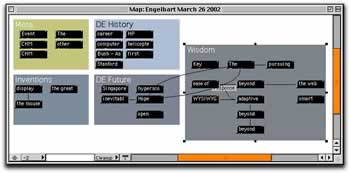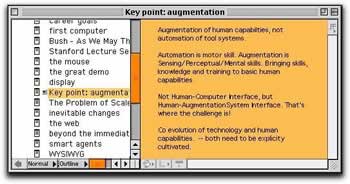Tinderbox in Meetings
Previously, he has been a technical writer and documentation manager for the database tools vendor Platinum Technology, Inc, a software engineer and project leader for EDS, and the founder of his own small software company. He also helped manage and nurture communities on the GEnie and eWorld online services.
Academically, Meyers past includes seminal work in the sociology of computer hackers, a long stint as an editor for Computer Underground Digest, and several years of performing magic onstage and behind the counter of a retail novelty and magic shop.

Instructional designer Gordon Meyer has been a Tinderbox enthusiast -- and innovator -- almost from the beginning. He's already shared with us the ways he used Tinderbox for taking notes and creating to-do lists. What's especially interesting about his approach to Tinderbox is that he's not very concerned with output: Meyer uses Tinderbox chiefly for gathering and analyzing ideas.
One of the things Meyer likes best about Tinderbox is its ease of use. When first trying Tinderbox for taking notes at a conference, he recalls, "I could rapidly add, name, then open each card for a quick jot. Return/Type a title/Return/Space/Type a note -- a quick and easy way to generate lots of nuggets," But the real utility of Tinderbox reveals itself later.
"Usually after an event like this, where I've taken notes in a text editor of some sort, I'll review what I've written the next day. When I have notes in a long scrolling document I never rearrange the order of the notes on the page. I get value out of retaining the chronology -- it helps me recall the event. Also, I feel that if I edit and change things too much I am, in some small way, falsifying my record of the event. That's probably my ethnographic background kicking in."
But because Tinderbox dates and time-stamps each note as it's created, keeping the chronology doesn't interfere with arranging them by content. "Reviewing my Tinderbox-captured notes from this event was a joy," Meyer says. "I could retain their chronology and also link, relate, and group items together. This led me to insights and subtleties that I had missed before."
Where many users rely on Tinderbox primarily to update and archive weblogs, Meyer has gone in deep for its organizational capabilities. "I'm just beginning to use Tinderbox for blogging, at a new site that examines onscreen help and documentation. (http://www.usablehelp.com/). Meyer also has a personal blog that he writes in Radio Userland. 'Wet Behind The Years' site is really just a playground. I ended up with that site because I am very interested in content management systems. So I'm exploring Radio Userland, approached from that perspective -- and since it is so well optimized for publishing a blog I fell into the blog."
"My interest in Tinderbox leans more toward content management -- keeping track of related ideas, notes, and the like -- the little bits-and-bobbles of a person with many interests and ideas. Tinderbox can do blogs," says Meyer, "but that is incidental to its purpose, at least to my way of thinking. Its the management side of the equation that interests me. Tinderboxs organization side is very flexible and visual. Note-taking and organizing can easily be done while listening. Results are visible right away, and reorganizations can be undone as easily as they were put into motion."
For instance, after the Engelbart lecture, Meyer describes organizing the thoughts that arose in response to his notes. "As these insights were popping out, I was eager not to lose them. In my pre-Tinderbox days, I would have scribbled additional notes, describing the connections I was making based on the material from the talk. It's an approach I've used for years, complete with a specific shorthand notational style for connections and tangents. It works, but often the extra material dilutes the overall information space and requires a lot of cross-referencing that, even if done clearly, can be awkward to reconstruct when returning to the notes later.
This time I used Tinderbox's linking tools to quickly add connections between the related objects. I used direction to indicate which note originated the ah ha in my mind, and the type of link tools to clarify what I thought the connection between them was.
One Tinderbox feature that helps to organize those "bits and bobbles are the varied view options. "The map view lets you to push your notes around and group them, much like index cards. I sorted my notes into a few basic piles, and then went back to look for connections, using both agents and the connections revealed by my preliminary sort." With Tinderbox, these connections could be made explicit, using links. "The map is handy for seeing new relationships and getting a different visually-interesting view of things. It can trigger new insights about an organization or overall trends."

In terms of the views Meyer uses most often, "I probably straddle the fence between map and outline approaches, he says. The map is fun and interesting, but awkward for me to use when organizing ideas. Outline view is much faster for that. For browsing what Ive collected, the explorer view is awesome. I use the keyboard to just quickly flip through the notes and get quick overviews of what I've got inside.

"When I first started working this way, I anticipated that I'd need extra attributes to help me organize the tasks. After all, nearly every To Do list manager I've used before was stuffed with categories, keywords, groups, and so on. But I'm finding that the built-in Tinderbox tools, combined with the Agents, offer more than enough power in this regard. I added a keyword attribute, but have never used it. I planned on even more Agents, but found that the built-in Find command is fast and an easy way to build ad hoc lists of tasks. Im a die-hard minimalist, so that influences how I work with Tinderbox.
One of the key features, to my thinking, and one reason why Im not hesitating to try different experiments with Tinderbox, is that it uses XML for data storage. Your data is not held prisoner. If the documents were some proprietary format I would have seriously hesitated before purchase. I've had far too many bad experiences with getting important data into a program and never being able to extract it. I like the XML choice for two reasons. I'm not an XML evangelist and or zealot. I like it because it is both 100% ASCII (so I can open it with any editor) and structured, so I have a chance at parsing out the bits if necessary.
Tinderbox is turning out to be a wonderful Tinkertoy. I'm quite pleased with the power and flexibility it brings to the table. It's a most impressive effort and clearly a labor of love and experience.
Try Tinderbox
for Mac OS X ❧ More download options.
Buy Tinderbox
Tinderbox for you, for your team, or your enterprise. Plus upgrades, The Tinderbox Way, and more. Order here.